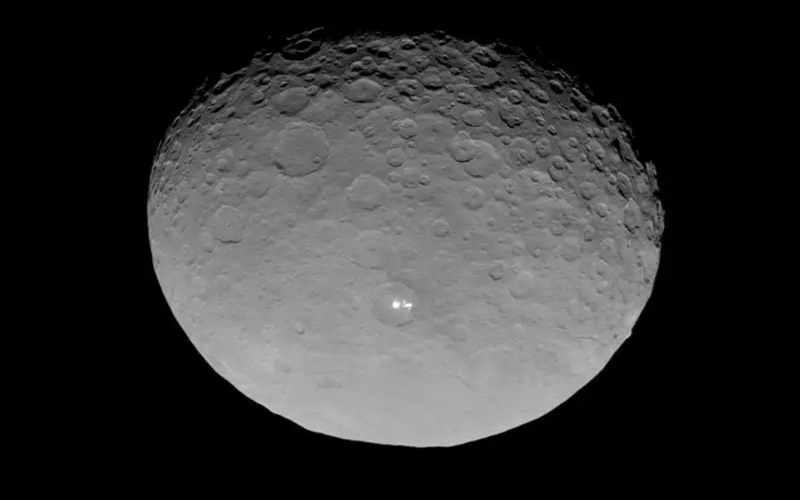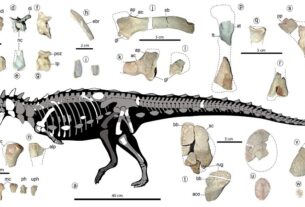For a long time, Eris, the most massive and second largest known dwarf planet in the solar system, was thought to have a solid rocky core topped by a layer of hard ice. A new model suggests the opposite: the surface of this object could behave like a soft cheese.
An intriguing dwarf planet
Eris was only revealed to astronomers in 2005 due to its extremely distant position in the solar system. It is 50% further from the Sun than Pluto, which is approximately 68 times the Earth-Sun distance.
The discovery of Eris in the Kuiper Belt had sparked significant discussions about the definition of planets, as it shared similar characteristics with Pluto, which was classified as the ninth planet in the solar system at the time. Astronomers were then faced with the question of whether to consider Eris and similar objects as planets in their own right or to reclassify them as dwarf planets.
This debate ultimately led to the revision of the official definition of a planet by the International Astronomical Union (IAU) in 2006, leading to the declassification of Pluto as a planet and the introduction of the category of “dwarf planets”. “.
Furthermore, the similarities of this dwarf planet with Pluto pushed Francis Nimmo, of the University of Santa Cruz, to study it further. As part of this study, the researcher spoke with Michael Brown, one of the scientists behind the discovery of Eris.
Tide Lock
Recent observations have revealed that this dwarf planet is rotating synchronously with its moon, Dysnomia.
The phenomenon of tidal locking is the result of gravitational forces between two celestial bodies orbiting each other. In the case of Eris and its moon, the tidal effect is strong enough to cause mutual locking, where the same side of Eris is always pointed towards Dysnomia, and vice versa.
The mechanism behind this involves mutual deformation caused by tidal forces. When an object, such as a moon, orbits a dwarf planet, it exerts a tidal force on that dwarf planet due to the difference in gravity between the near and far side of the planet. This tidal force creates deformations, or “bumps,” on the dwarf planet.
If the dwarf planet is flexible enough, these deformations can then cause internal friction, dissipating energy in the form of heat. This process of energy dissipation acts as a brake, slowing the rotation of the dwarf planet. Over time, tidal energy dissipation can lead to mutual locking.
In the case of Eris, the researchers observed that this process of energy dissipation was particularly important. In other words, it loses energy more efficiently than expected. This data is crucial to understanding its internal composition.
A particularly soft surface
However, there was still one piece missing from the puzzle. Researchers didn’t know exactly how big Dysnomia was.
To find out, they looked at unpublished data from Michael Brown. These showed that the moon of Eris must have a mass below a certain threshold. This upper mass limit was crucial for researchers in developing a model describing the dynamics between the dwarf planet and its moon.
The mass ratio between Eris and Dysnomia, observed using the large millimeter/submillimeter network of Atacama, then played a determining role in understanding the internal structure of Eris.
According to this model, Eris has a structure similar to that of Pluto, comprising a rocky core surrounded by an icy shell. However, unlike Pluto, which has a conductive ice shell, Eris’ ice shell appears to exhibit convective motion. This indicates that the ice is moving and transferring heat, playing a crucial role in the observed dissipation process.
In other words, this means that Eris’ surface is softer than Pluto. According to the researchers, it could behave like a soft cheese or like a slushy.
So while Eris was sometimes considered a “twin” of Pluto because the two are very similar in size, these results show that they may not be as similar as previously thought.
This convective feature of Eris’ ice shell could result from the apparent lack of volatiles compared to Pluto. This disparity could arise from a more energetic impact in Eris’s past, potentially resulting in a significant loss of volatile materials.
Dwarf Planet Key Points
1. Eris, a distant dwarf planet, challenges prior assumptions about its composition.
2. Discovered in 2005 in the Kuiper Belt, Eris triggered debates about planetary classification, leading to the creation of the “dwarf planet” category.
3. Eris and its moon, Dysnomia, exhibit tidal locking, influencing their rotational dynamics.
4. Tidal forces cause mutual locking, revealing insights into Eris’s internal composition.
5. Eris’ surface, softer than Pluto’s, displays convective motion in its icy shell, resembling a soft cheese or slushy.
6. The study suggests a potential energetic impact in Eris’s past, leading to differences in volatile materials compared to Pluto.




